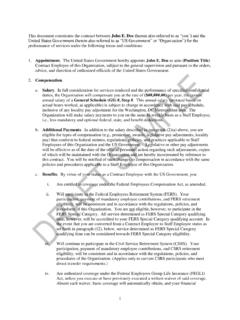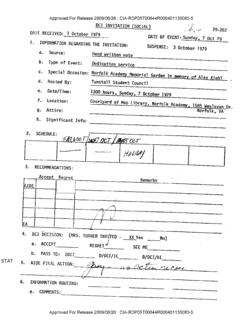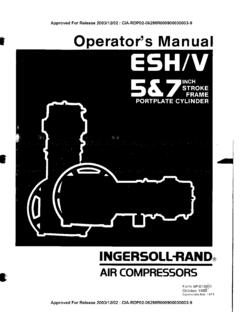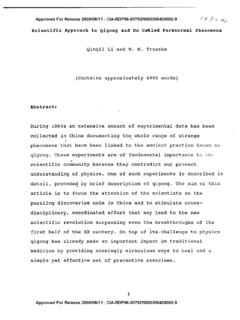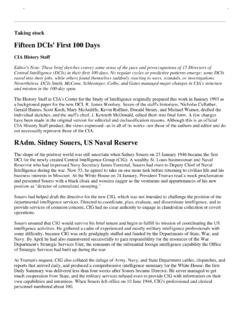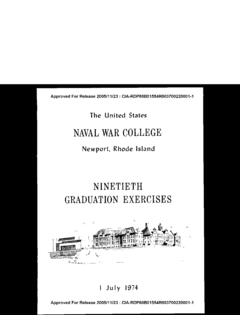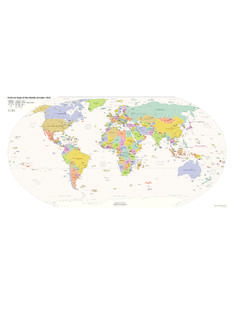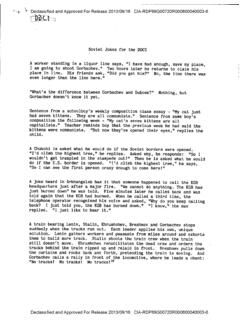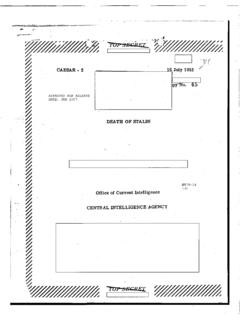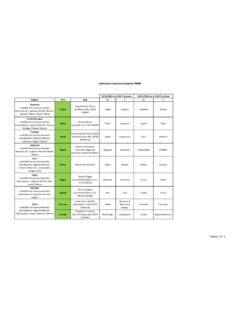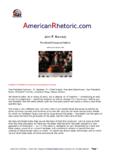Transcription of G t Getting to Know K The President
1 The PresidentGetting to KnowIntelligence Briefings of Presidential Candidates andPresidents-Elect 1952 2016 FOURTH EDITIONJohn L. HelgersonG e t t i n g to KnowT h e P residentIntelligence Briefings of PresidentialCandidates and Presidents-Elect1952 2016F O U R TH EDITIONJ o h n L . HelgersonThis book has been prepared primarily for the use of US government officials. The format, coverage, and content are designed to meet their requirements. Publications are not generally available to the public directly from the Central Intelligence Agency, however, this book is available on the Internet at: statements of fact, opinion, or analysis expressed are those of the author and do not reflect the official positions or views of the Cen-tral Intelligence Agency (CIA) or any other US government agency. Nothing in the contents should be construed as asserting or imply-ing US government authentication of information or CIA endorse-ment of the author s views. This material has been reviewed by CIA solely for published in 1996; reprinted in 2001; Second edition pub-lished in 2012; Third edition published in 978-1-929667-34-5iGettinG to Know the PresidentFourth EditionintelliGence BriefinGs of Presidential candidates and Presidents-elect, 1952 2016 john l.
2 HelGersonCenter for the Study of IntelligenceCentral Intelligence AgencyOctober 2021ii Getting to Know the President , 1952 2016 The Center for the Study of Intelligence: CSI s core mission is to en-hance the operational, analytical, and administrative effectiveness of the CIA and the Intelligence Community by creating knowledge and understanding of the lessons of the past, by assessing current prac-tices, and by preparing intelligence officers and their organizations for future challenges. To support its work, CSI publishes Studies in Intelligence, books, monographs, documentary films, and web-based content addressing historical, operational, doctrinal, and theoretical aspects of the intelligence profession. Past unclassified publications produced by CSI include:A Middle East Primed for New Thinking: Insights and Policy Options from the Ancient World, by Andrew Skitt Gilmour (2019)The History of CIA s Office of Strategic Research, 1967 1981, by Rob-ert Vickers (2019)ARCHANGEL: CIA s Supersonic A-12 Reconnaissance Aircraft (Sec-ond Edition, 2011), by David Robarge, CIA HistorianThe Agency and the Hill: CIA s Relationship with Congress, 1946 2004, by L.
3 Britt Snider (2008)Directors of Central Intelligence as Leaders of the Intelligence Community, by Douglas F. Garthoff (2005)Psychology of Intelligence Analysis, by Richards J. Heuer, Jr. (1999)These and other publications may be found at and comments may be addressed to:Director The Center for the Study of Intelligence Central Intelligence Agency Washington, DC, 20505iii Getting to Know the President , 1952 2016To Claire, Ian, and Annaiv Getting to Know the President , 1952 2016 john Helgerson reviewing materials for his briefing of Governor Bill Clinton at the Arkansas governor s mansion. Helgerson was CIA s deputy director for intelligence (analysis) at the time. v Getting to Know the President , 1952 2016 john L. HELGERSONMr. Helgerson was the Central Intelligence Agency s inspector gen-eral from 2002 until his retirement in 2009. Previously, he served as chairman of the Intelligence Community s National Intelligence Coun-cil and deputy director of the National Imagery and Mapping Helgerson began his career in government as an analyst of Af-rican politics at the CIA.
4 At varying ponts he headed units responsi-ble for coverage of Africa, Latin America, and Europe. He served in a number of senior management posts, including deputy director for intelligence and director of congressional affairs. Prior to his government service, Mr. Helgerson was an assistant professor of political science at the University of Cincinnati and a re-search affiliate of the University of Zambia in Lusaka. He specialized in international relations and African native of South Dakota, Mr Helgerson graduated from Saint Olaf College in Northfield, Minnesota, and received and degrees from Duke University in Durham, North is the author of all four editions of Getting To Know the Helgerson has received a number of awards and commenda-tions, including the National Intelligence Distinguished Service Med-al, CIA s Distinguished Career Intelligence Medal, and NIMA s Distin-guished Civilian Service v vGetting to Know the President , 1952 2016viiForeword.
5 XiForeword to the First Edition of Getting to Know the President ..xiiiPreface ..xviiIntroduction ..1 Chapter 1: Truman and Eisenhower - Launching the Process ..5 Strained Relations Complicate the Arrangements ..9 Preelection Briefings ..12 Support to the President -Elect ..15 The New President as an Intelligence Consumer ..20 Briefing Governor Stevenson in 1952 ..24 The Challenger Briefed Again in 1956 ..25 Chapter 2: Into Politics with Kennedy and Johnson ..29 The Presidential Debates ..29 Preelection Briefings: What Really Was Discussed? ..34 The Missile Gap ..37 Postelection Briefing on Cuba ..42 Other Covert Programs ..44 The Mystery Briefing of Late November ..47 Kennedy Visits the CIA ..49 Origins of the President s Intelligence Checklist ..50 The Transition to President Johnson ..54 Vietnam ..57 Evolution to the President s Daily Brief ..61contentsviiiContentsGetting to Know the President , 1952 2016 Chapter 3: Nixon and Ford - Uneven Access ..65 Supporting Nixon s Team in New York City.
6 69 The Key Player: Henry Kissinger ..72 Nixon Remains Aloof ..78A Closer Relationship With Ford ..82 Discussing Operations and Intelligence ..86 Political Problems Undermine the Briefing Process ..89 Chapter 4: In-Depth Discussions with Carter ..93 Extended Preelection Briefings ..95 Operational and Political Issues Arise ..104 Carter s Use of the President s Daily Brief ..112 Chapter 5: Reagan and Bush - A Study in Contrasts ..121 Postelection Briefings ..125A Higher Level of Daily Support ..129 After the Inauguration ..134 The Transition to President 6: Briefing Governor Clinton in Little Rock ..143 The DCI Visits Little Rock ..143 Establishing a Permanent Presence ..145 Substance of Discussions ..149 Other Opportunities To Help ..155 Great Support Made It Work ..159 What Was Accomplished ..162 Chapter 7: George W. Bush - Demanding Consumer ..165 The Presidential Debates ..170 Postelection Briefings ..171 Vice President -Elect Cheney ..175 Covert Action Briefing ..177 Strong Supporting Cast.
7 178 Impact of Austin ..183 President Bush as a Customer ..185 Intelligence and Politics ..187 Kerry and Edwards Briefed in 2004 ..189 Chapter 8: Barack Obama - A Careful Reader ..195 Preelection Briefings ..197 Presidential Debates ..200 Transition Briefings with the PDB ..201ixContentsGetting to Know the President , 1952 2016 Briefing the Vice President -Elect ..207 Other Briefings of the President -Elect and his Team ..208 Support of the Briefing Effort ..216 Politics of the Transition ..219 President Obama in Office ..221 Romney and Ryan Briefed in 2012 ..224 Chapter 9: Donald J. Trump A Unique Challenge ..231 Preelection Briefings ..236 Briefings during the Transition ..241 President Trump in Office ..260 Afterword - Concluding Observations ..269 Patterns of Support ..270 What the Presidents Recommend ..273 Keeping Out of Politics ..278 The Arrangements Make a Difference ..280 Material That Was Welcome ..284 Index ..289v v vGetting to Know the President , 1952 2016xiforewordThe Central Intelligence Agency is more of a presidential service or-ganization than perhaps any other component of the US government.
8 Since 1952, CIA and now the Intelligence Community have provided presidential candidates and presidents-elect with intelligence briefings during their campaigns and transitions. These briefings have helped presidents be as well informed as possible on international develop-ments from the day they take addition to their central, substantive purpose, these briefings usually have also served as the IC s introduction to the First Custom-er, the individual who, more than any other, determines what place in-telligence will have in the national security hierarchy. They have been crucial in giving an early sense of the personalities of the candidates and presidents-elect, their knowledge of world affairs, and their views of how intelligence and the IC can best support national security to Know the President by john Helgerson makes a singular contribution to the literature of intelligence by describing this import-ant process of information sharing between the IC and the chief ex-ecutive.
9 First published in 1996 and now revised and updated for the third time to include accounts of intelligence support to candidates and presidents-elect in the six elections between then and 2016, Hel-gerson s study provides unique insights into the mechanics and content of the briefings, the interaction of the participants, and the briefings effect on the relationships presidents have had with their intelligence services. His observations on how and what to brief during the cam-paign and transition periods are essential reading for members of the xiiForewordGetting to Know the President , 1952 2016community charged with that responsibility in the future and seeking to learn from the best practices of their his 1996 foreword to the first edition of this book, Christopher Andrew took note of the simple but important fact that each President is different. From that point flows another explanation for the second, third, and now this fourth edition. Prepared under the sponsorship of the Center for the Study of Intelligence, this continuing work reflects CSI s and the CIA s commitment to the examination, and reexamina-tion, of the profession of intelligence in the United States.
10 This effort has been manifest in products of many kinds, unclassified and classi-fied, with many of the latter eventually released wholly or in part to the with other dimensions of the IC s and CIA s work, service to pol-icymakers and presidents demands both the scrutiny of today s prac-titioners of intelligence and the perspective of historians to follow. While this book is primarily intended to serve those who must con-sider the IC s role in a presidential election year, it is also hoped that it will help illuminate as much as possible for others the nature of CIA and IC service to past presidents, while at the same time keeping faith with the essential confidentiality to which sitting presidents are RobargeChief HistorianCentral Intelligence AgencyGetting to Know the President , 1952 2016xiiiforewordto the first edition of Getting to Know the PresidentThis is an important and original book. How world leaders under-stand or misunderstand, use or fail to use, the intelligence available to them is an essential but still under-researched aspect both of modern government and of international relations.
